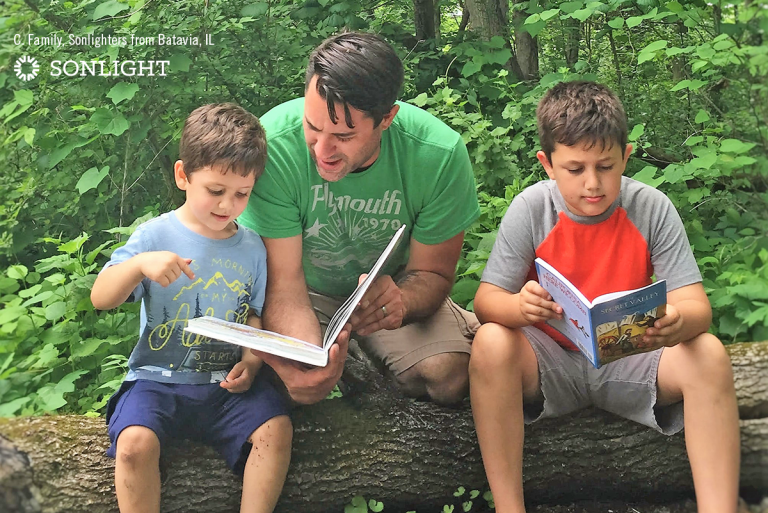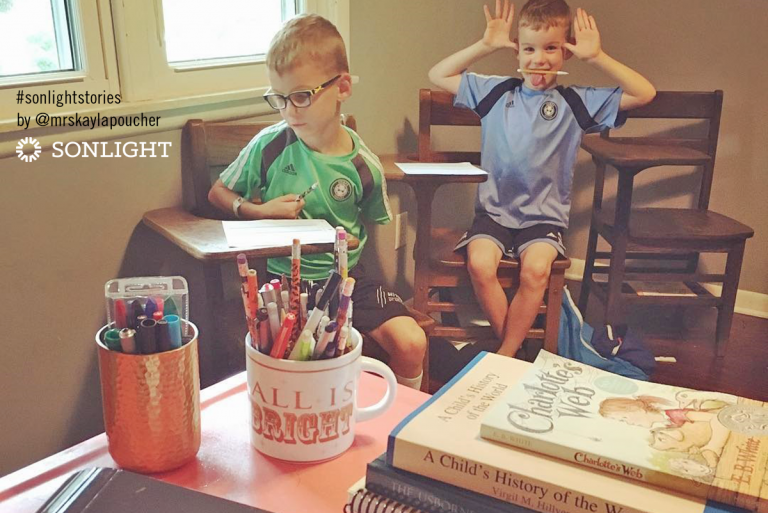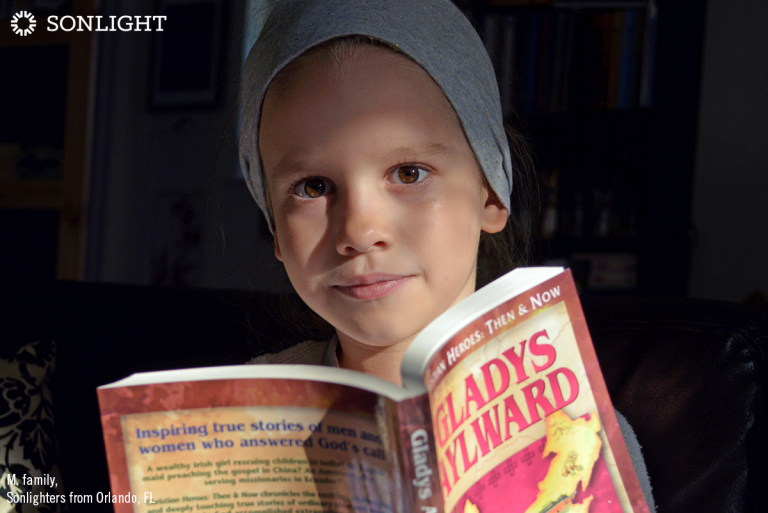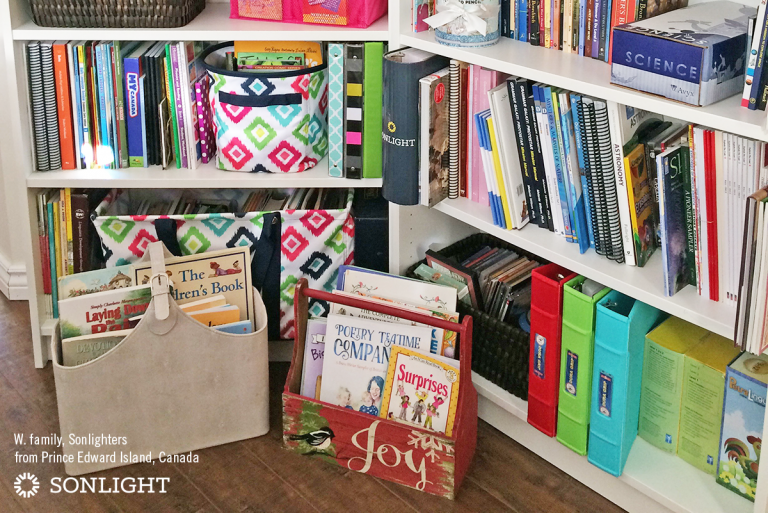Discover how biographies enlighten your children on their adventure of learning.
Continue readingMost Popular
The 14 Best Christian Homeschool Programs Jan. 11, 2024The Top Summer Reading List For Middle Schoolers Jun. 4, 2024
Article Categories

My mom’s bedroom is right down the hall from us. She moved in shortly before my second child was born. She has been a constant in their lives since they were little. She helps feed them, dress them, play with them, and yes, educate them. In our home, Grandma is a vital part of our homeschool experience. We have an intergenerational approach to homeschooling.
When we elected to homeschool—a decision my husband and I researched extensively—it was important for us that Grandma also be on board. I value my mother’s opinion and I hope my daughter grows to value mine as well. Thus, when we chose to homeschool, I was very careful to introduce it as something we were going to commit to fully and not merely a passing fad in our parenting. Fortunately, my mom quickly understood the myriad benefits of homeschooling and was on board with the decision.
My mom has been instrumental in their education from day one. I’d be hard pressed to find a day when my mother wasn’t singing nursery rhymes, reading books, or letting my children help her prepare something in the kitchen. So when we began to research curricula, it was essential that we all be comfortable with our choice. All three of us would be working together to raise and educate our kids. We would be homeschooling in an intergenerational home.
One of the best decisions we made was to use Sonlight as our base curriculum. The materials are well suited for use with a family that has more than one pair of hands in the “homeschooling kitchen.” As I type this, I can hear my mother laughing while enjoying a read aloud with all three kids in the other room. While dinner is being made, my husband will likely be pouring over one of the Usborne Science books with the kids in awe over the amazing facts and beautiful illustrations. We benefit greatly from being able to complete the Read-Alouds, Bible stories, and Science experiments as a family, with all three adults participating.
Having other adults interested in what the kids are accomplishing provides a built in show-and-tell. My daughter loves to show her Timeline Book to her father and grandmother and introduce them to the characters she has met this week, whether Adam and Eve or Abraham Lincoln. The children involve all of us in pretend play featuring their favorite characters. For example, while reading The Boxcar Children, we built pretend campfires, pressed flowers, and learned how to wrap a dog’s injured paw.
Like every other homeschooling family in the world, we have exceptionally good and exceptionally bad days. Homeschooling with three strong-willed and opinionated adults in one house can get tricky. Keeping track of who is doing what when can become overwhelming at times. More than once we have found ourselves promising a trip to the park when another adult had already planned to finish a Read-Aloud. Through trial and error, our family has identified key strategies for making the most out of homeschooling in an intergenerational household.
While this may seem obvious, it can be almost impossible to homeschool successfully without everyone in the household being on board.
Clearly communicating your goals as a family is key for peaceful learning. We have a clear plan showing what activities have to be completed before moving on to the next level of activity.
Make a clear notation of who will be covering which items on the to do list or in the Instructor's Guide (IG). We know several families that have success with Dad covering Science, Mom leading Language Arts, and Grandma reading the read alouds. We chose not to do go this route because we wanted the kids to see each of us working with them on the different subjects even if they were not our favorites. Instead we typically let the child choose what he or she wants to do with us next and then sign off when it’s done so the next adult up to bat can see what was covered.
Make sure that all the adults are familiar with how to track completed assignments. We simply place the child’s initial after the completed assignment on the IG. You may also find it beneficial to discuss what needs to happen in order for the assignment to be deemed complete; decide if you are looking for coverage or mastery of the material.
Making sure all necessary materials for a science project are available or the current Read-Aloud is nearby can help ensure schooling gets done. Our current Read-Aloud is always kept at the same place in the kitchen. Sometimes we have more than one Read-Aloud going at a time, so that whichever adult has started the book can also finish the book. We enjoy the stories too and don't want to miss out on any chapters!
Life is going to happen. Sometimes reading aloud is the only thing that gets done. Perhaps there is a struggle with some element of handwriting. We do our best to be patient, pray, and be prepared to adjust routines as needed to best fit our family.
Focus more on relationships and connection versus mastery of academics. Family should always come first. For us, God is at the very heart of family. Learning and education should never come at the expense of these relationships, but foster, encourage, and grow the family.
Sharing the responsibility of homeschooling over more than one generation can be challenging, but hugely rewarding both for the kids and for the adults! If you have family either nearby or sharing a home with you, I encourage you to include them in your educational plans. I hope you too will be able to find the joys that can be found in intergenerational homeschooling!
A clear homeschool plan—such as the ones laid out in Sonlight Instructor's Guides—is key for intergenerational homeschooling.
Try three weeks of any Sonlight Instructor's Guide for free, preschool through twelfth grade.

Nothing has taught me more about my children than homeschooling. No other situation or experience has given me such a close look at their personalities, likes, dislikes, passions, and frustrations. However, this lifestyle has also given me a closer look at how I'm wired too: I'm task-oriented.
Not only do I love those neat and tidy boxes on my list, I also like to fit inside “the box.” I like to know my place. I like to know where my piece fits in the puzzle. To me, “the box” gives meaning. The box helps me understand myself.
We just finished our third year of homeschooling, and I've come to learn that though homeschooling is outside of the box for many, it is still a world full of its own type of boxes. Oh, how I'd love to squeeze us into one of those easy-to-understand categories and simply be able to say, “We're classical!” or “We unschool” (which is another box entirely)!

But when you homeschool overseas with hardly any other homeschoolers (not to mention a useable library) in sight, those preconceived boxes become meaningless. You're faced with the task of creating a brand new box. So what does our expat homeschooling look like?
In a nutshell, it is a classically-bent, unit-study-loving, interest-led-when-applicable, worldschooling-when-there's-opportunity, semi-year-round-depending-on-our-travels, unschooling-on-the-tough-days kind of homeschooling.
Take that, box!
On paper, it's enough to make my list-loving self completely lose it. How could a box-checker ever thrive in such a situation? Moving overseas, homeschooler or not, makes all your preconceived boxes null and void. Believe me, it's a painful learning process. But I know I'm a better person for it—definitely a better homeschool mom for my kids who have never lived long term in the American, box-driven, list-checking culture. All together we can explore the fact that learning comes from life, not a list.
The first thing that appealed to me about Sonlight (after the amazing books, of course) were the Instructor's Guides (IG) with beautiful boxes to check off every day. Here is a curriculum that is one big list. But no matter where you live, life never goes according to plan on a daily basis. There are places to go, people to see, bad attitudes to suffer through—all things that could potentially dismantle a day.
To counter this, I reinvented my box. Instead of a daily schedule, I shoot for a weekly list. For example, an assignment scheduled on week 14 day 1 of the IG could get done at any time during week 14. To zoom our schedule out a little more, we take a week off after every six weeks. So if that science experiment (a.k.a. the bane of my existence) assigned during week 2 doesn't get done until week 5, I can still function. I can still see our progress. I can still fit it in my own reconstructed box.
The danger of boxes is that we too easily fear what's outside of them. And once we stumble upon someone who claims to be sharing our same box, we start comparing. Teddy Roosevelt said, “Comparison is the thief of joy,” and I think where homeschooling is concerned, truer words have never been spoken. Even if we were doing the exact same curriculum but were still living in the States, our experience would look vastly different.

Sometimes, my mom-guilt kicks in (I know you can relate) and unkindly highlights ways that our situation is robbing my children of opportunities. However, when I have more clarity, I'm able to see how our current life offers experiences the vast majority of their American peers will, perhaps, not ever have.
A mom who is able to relax her box-boundaries and put aside her pretty lists is one who can encourage her children's unique personalities to flourish.
Some days, I still long for my list on pretty stationary inside my box, wrapped up in a cute ribbon. But these days my box is bigger and the sides are pretty beat up from being cut open and crudely taped back together in different shapes over and over again. There's no need to wrap it up in a pretty ribbon when I know I'm going to end up reshaping it soon anyway. I've even poked a few air holes in the sides for good measure. I love where our homeschooling journey has brought us thus far, and I'm very much looking forward to see where it takes us from here.
Sonlight gives you options for creating a unique homeschool experience that fits you! Go to SmoothCourse and get started today.

My four children all had very different experiences in regards to their early education. Things simply weren’t equal for them.
Amy remembers growing up in California, but Justin’s memories all come from after we moved to Colorado. Jonelle usually tagged along with what I taught Luke, and Justin says I never taught him Algebra (though I dispute that claim!).
Public schools can be very focused on moving children along in lockstep with each other. Many teachers lament how much time they have to spend teaching to the test. They have specific goals they need to meet at each grade, regardless of what the individual children in their classroom actually need.
Do you need to give each child the same homeschool experience?
With homeschooling, you don’t have to teach to the test. You can teach to your reality.
If your reality is that your first child has learning challenges and your second child is a math prodigy, then you can tailor their education accordingly. If one teenager loves to write and the other wants to be an engineer, you can take them down different paths. If one child requires structure and schedules, but another is more of a free spirit, you can adjust accordingly. If your reality is that you just adopted a child and your whole family needs time to adjust, you have the freedom to prioritize family time in your schedule.
I appreciate some of the wisdom from Siblings Without Rivalry here. The authors write,
"...children don’t need to be treated equally. They need to be treated uniquely."
Instead of trying to replicate a certain educational experience for each child, it’s far better to see what each child needs and give them that. And instead of trying to make your family look like some ideology’s concept of the perfect family, you can treat your family uniquely as well.
As your family grows and changes, you can play to your strengths at each stage. When you just had one child, you could give her your undivided attention as you constantly read to her. That was a strength of that stage, and you made the most of it.
When your second was born, he simply didn’t get as much of your undivided attention. But he did get the additional love and attention of an older sibling from day one. And he benefited from parents who had a little less anxiety and a little more wisdom the second time around.
As you and your family grow and change, you can continue to look at your particular family situation and your particular students and make the best decisions you can … even if it means a younger child’s experience is different than an older child’s.
For example, I advocate combining your children in the couch subjects when you can, and providing individual levels for the table subjects. So when you choose your History / Bible / Literature program, you can combine children within a few years of each other. Same for Science. Gather on the couch and read and learn together with those great books! When it comes to Math, Language Arts and Handwriting, you’ll probably need to sit your kids at the table with their own individual levels.
Combining couch subjects inherently means your children will have different experiences. You might start World History when your first is 8 and your second is 6. Of course, an 8-year-old and 6-year-old will get different things out of the same books and conversations. But both children will be learning age-accessible material in the context of a loving and inquisitive family. And that’s what counts. There is no magic window of time in a child’s development in which they must study any particular period of history.
Or maybe you were more scheduled and rigid when your first-born started kindergarten. By the time your fourth started, you’d relaxed a lot. But both children experienced kindergarten in the context of your loving family. Great!
So let go of any guilt around the idea that everything needs to be equal for your children in order to be good. Your children need you to treat them as unique individuals. And that is one of the greatest strengths of homeschooling. You can treat each student as the unique individual he or she is. You can treat your family as the unique, messy and beautiful entity that it is.
May God bless you as you raise your unique family according to your unique situation!
Ready to design a unique educational plan for your children? Go to SmoothCourse and get started today.

I’ll be honest. One reason I love Sonlight is because I can use a single program, branching off as necessary to match the various ability levels of my kids. However, this year, I really wanted my younger children to go through History / Bible / Literature (HBL) Level B (because every child needs Intro to World History, 1 of 2 in their life!) while my older children needed and wanted to stay on course and move on to Sonlight HBL F for ages 10-13.
So here I am, back once again in the land of multiple children covering multiple Sonlight Levels. It’s okay though. I’m not new to the concept. Today, as I am doing my summer planning for next year, I’m reviewing my best strategies for teaching multiple children in different levels. These aren't pie in the sky tips. These are realistic methods that have worked for me in the past and that I'll be implementing again for a fresh season of homeschooling.
Continue reading below or listen here:
This is probably my best tip for homeschooling multiple Sonlight Levels—block your time. Here's how I do it. Every morning, from 9:00-10:00(ish), I have a Math Block. I rotate my kids through their lessons in 15 minute time slots. If someone isn’t grasping the concept in 15 minutes, I make a note to revisit it later in the afternoon. Frustration usually sets in at the 15 minute mark anyway, so it’s actually a good time to take a break.
After a nice, long recess, we gather together again for a Language Arts Block. I follow the same principle here. We rotate through 15 minute time slots and go through the Language Arts assignments for the day. While I’m working with one child, the others are doing some of their independent work for the day.
After lunch and another recess, I’ll run Sonlight Blocks. This is where we get together, read great books, have in depth discussions, and do any science experiments or activities listed in the Instructor’s Guide (IG). If my younger kids want to sit in while we do Level F, that’s okay. If not, that’s okay too.
I approach homeschooling as a full time job. I generally don’t try to clean house or do other things during the day, so my kids get a lot of my time. However I also require a good portion of independent work time from my children.
Once we’ve gone over their Math or Language Arts assignments, they have practice work to do independently. When they finish their list and their rotations for the day, they are done and can have free time. If they don’t finish, they have to keep working. This incentive seems to be all my kids need to encourage them toward independence.
If they have a question, they know that I’m available, but they also know that they are personally responsible for their work to be completed well. If you want to move your children towards more independence, look at your schedule and figure out which assignments your child could do without you. Get a simple assignment book to write down their solo assignments each week, and train them to work through their list every day.
Audiobooks are essential when you’re teaching more than one level. This year, I was able to purchase several audiobooks for Level B which both gave my voice a rest and also served as a genuine time saver. Libraries usually keep a great selection of audiobooks to check out anytime. When we use audiobooks, I will simply write in their assignment book, “Listen to two chapters of Charlotte’s Web on my phone.”
Remember that children don’t necessarily compartmentalize things like adults do. Just because you are studying the Great Wall of China with one child doesn’t mean that same child wouldn’t enjoy listening to a Read Aloud about Lewis and Clark from another child’s level. If you have a book that you think everyone would enjoy, by all means, read it to everyone. You can either skip a book in the other level, double up, or use the audiobook option.
When you choose your levels, consider selecting complementary levels. For example, I find that Level B goes well with Level G because both are World History. Levels D and E are excellent companions to Level 100. If you can, schedule these levels together, and you’ll be surprised by all the concepts you can combine. (See the full Sonlight History Scope and Sequence here.)
When you teach multiple levels, you’re going to end up skipping a few books. You just are. Accept it now so when it happens, you won’t be bummed. I am never bothered by skipping a book here and there though, because I know that I’ll come back to those books for summer reading.
Like most homeschooled kids, my kids don’t really ever have a total summer break. I’m always reading something to them, so having a few leftover Sonlight selections to read in the summer is never a problem.
I know some families that don’t do Science during the school year; instead they spend their summers working through the Science IG. Sometimes we fall behind on our HBL work, so we continue our Bible and history readings through the summer. Think outside the allotted 36 weeks. There’s more than one way to execute your plan.
Spend a few days in the summer time preparing for the school year. Take apart the IG for each level and file it in hanging file folders labeled by week. That way, you can grab all the week’s IG pages for every level and every subject in one swipe. Bind, file, or place in a folder all your kids’ activity pages and workbook pages for each week as well so that they are easy to grab and hard to lose. A little bit of planning in the summer time goes a long way when you’re in the midst of a busy school year.
Teaching multiple levels is actually easier than you might expect when you don’t overthink it. Don’t stress, and don’t be afraid to take it on. You can do it, and your kids will love it!
If you are wondering how to teach multiple levels with your particular mix of children, our Advisors can help! Click here to connect with your homeschool consultant.

Worldview formation begins long before high school-level worldview courses, long before a child ever knows the terms apologetics, theology, or politics. By the time we as homeschool parents begin to make curriculum decisions for our children—much less prepare a high school transcript—we’ve already spent long hours teaching and modeling worldview.
It began the moment we first helped our daughters or sons begin to sort out appropriate ways to navigate choices. When we teach our little ones to say please, to communicate in words rather than screams, and to refrain from pushing siblings, we’re building the foundation of the viewpoint from which they will interpret everything they encounter. We model worldview, too, in the books we choose to read to aloud. As parents, we delineate right and wrong, good and evil, in these basic ways from the very beginning.
As our children grow, their environment expands and so too does their awareness of right and wrong. As caring parents, we may be tempted to shield them from evil for as long as possible. In many circumstances, this is the correct and the wise decision—but it’s not quite as simple as that.
As a missionary kid born abroad, I saw peeks into evil at a young age. I knew angry villagers attempted to kill my father by hurling rocks and stones at him. And in another country, I knew the state was vehemently opposed to the ideas in the stacks of Bibles he’d stuff into duffel bags and smuggle overland, beyond the Iron Curtain. But here’s the thing—these glimpses of evil served to fill me with an overwhelming sense of awe at how powerful and majestic God must be if people would go to such lengths to oppose Him.
When my daughter was in kindergarten, she could recite back to me, “God is good." But having led a delightfully safe and secure life, she had no concept of what good actually was. Good, in fact, was all she knew.
As we snuggled together and read aloud from History / Bible / Literature A, she was gently introduced to the clash between the Egyptians and the Israelites, and (in a now-retired Sonlight book) the clash between the Vikings and the Lindisfarne monks, too. As we read, a light bulb went on for her, and I was witness to a powerful and profoundly developing sense of truth versus evil. “The way to glorify God, mama,” she would tell me, “is not to do idol worship and not to pray to kings. Only pray to the one true God. Egypt and Jerusalem were similar, Momma. Both had king-people who did not worship the one true God. Both had king-people plotting to kill! Both did not pray to God, but to false kings and false gods."
The Israelites of old were instructed to teach their children not only God’s covenant, but also the battles and exploits of heroes of faith who had gone before. When the Israelites instructed their children, the triumph of God was always taught in context of the opposing evil. These conquests were not stripped of all information about the pagan nations, or presented in sanitized, rewritten form, showing only the Israelite’s actions. In Exodus 13:14, we read the following: "And it shall be when your son asks you in time to come, saying, 'What is this?' then you shall say to him, 'With a powerful hand the Lord brought us out of Egypt, from the house of slavery.’”
How would this deliverance be remarkable at all unless we understood the oppression God’s people had been under? Would early Christian martyrs stand out as phenomenal examples of dedication to the cross of Christ, if we minimized the evil leading to their execution?
History needs to be told in context. This is why I love Sonlight so much. Stories provide context in a way that rewritten textbook sources never can. While it is admirable to wish to tell history from a Christian perspective, this attempt to smooth over the mess can be problematic. As our children get older, we must be careful to resist the temptation to paint rough patches of history in a purely positive light, or whitewash history to the point of inaccuracy.
If we take this paraphrasing too far, for too long, we do our children a disservice. The powerful triumph of victory over evil is lessened if we continually downplay the extent of evil. We need to be carefully not to accidentally narrow the gap between good and evil, between right and wrong, between light and darkness, or between truth and deception. We need to tell the whole story—and Sonlight books do an excellent job of this. We must give our children real stories of real people, not just sanitized retellings. We must teach not only the good alone, but also of good’s triumph over evil.
The essence of teaching worldview, after all, is to equip children to effectively differentiate between the two.
Ready to explore an educational option that helps you impart a Christian worldview? Go to SmoothCourse and get started today.

When you use a literature-rich program for homeschool, you don't ever outgrow your curriculum. Although reading skill grows and Readers increase in difficulty, your Read Alouds, biographies, and nonfiction titles remain a valid part of your home library, enriching your experience again and again through the years.
That's why we encourage you to grow your family's library by keeping—not reselling—your homeschool curriculum. I'd like to offer you three reasons why.
This is an enormous benefit. With Sonlight, your children enjoy so many favorite books that they will want to read repeatedly. And every time, they will learn something new. Or will learn something old more deeply.
This was Sarita’s experience with her children. She often found them reading and re-reading books they had read even years before. Because they were that much fun and that engaging. And each time, something new was planted in their hearts.
Now Sarita’s grandchildren pull out books from Sonlight programs they’ve finished. They cross-reference what they’re learning currently with what they’ve learned in the past: ancient ships, maps from the time before Columbus, animal facts (usually to prove a point to a parent).
Even a dyslexic grandson, who does not yet read books on his own, will pull books from previous programs in order to prove a point. “Remember how we read about the triremes?” Or “Like in this book—everyone dies.” And an artistic grandson will imitate some of the drawings.
Many weeks Sarita's daughter will round up and re-shelve a dozen Sonlight books that aren’t part of current studies. Her grandchildren are actively using their Sonlight books.
If you sell your Sonlight books, or if you have to return them to the library, your children will miss this layered learning effect.
Books are quite durable. And if a book wears out from over-love, what a way to go! While you may have to buy the occasional replacement, the vast majority of Sonlight books are purchase once, reuse again and again.
When you read a book the first time and fall in love with it, you are finding out how the story unfolds. When you revisit a book, you remember (either entirely or at least a bit) how the story unfolds.
But now you can enjoy the pleasure of reading a story you know you love, with the memory of the first time you read it. And that past experience with the book makes the experience richer.
You notice details you missed the first time—the hints along the way. You know the book is beautiful, so you read it without the question of whether you will like it. You know that you do . . . and will again.
If you sell your Sonlight books, or if you have to return them to the library, you are parting with book friends.
It's the trendy thing these days is to be a minimalist. The fewer items you possess, the closer you are to zen perfection, or something like that.
And I am not one for mass possession, but I make room for my books.
Daniel Levitin, in The Organized Mind, summed up part of the reason to keep your Sonlight collection. He says,
"Another thing that has been lost with digitization and free information is an appreciation for the objects in a collection. A person’s music library was once, not so long ago, a collection to admire, possibly envy, and a way to learn something about its owner. Because record albums had to be purchased one by one, because they were relatively expensive and took up space, music lovers compiled such libraries deliberately, with thought and planning. We educated ourselves about musical artists so that we could become more careful consumers. The costs of making a mistake encouraged us to think carefully before adding a clunker to the collection. High school and college students would look at a friend’s record collection and wander through it, allowing themselves a glimpse of their new friend’s musical tastes and the musical paths that he or she presumably crossed to acquire this particular collection of music."
Change record albums to books, and musical artists to authors, and his point applies to your homeschool curriculum. What you own says something about you. If you own a television in every room, you are communicating something about what you value. If you own twenty-five designer purses, you’re communicating something else.
A home library communicates that your family is curious, interested in history and stories, and tends more towards books than towards digital products when it comes to education and information. When people come to visit, they get an idea of what you’re like as a family based on your bookshelves (whether they ever browse them or not).
While you can carry a large library of ebooks on a device, if your books are hidden on an ebook reader, you miss the social benefits that physical books offer when they quietly declare who you are:
A physical library tells everyone who enters your home a little bit about who you are as a person. The titles of the books themselves show your interests, concerns, and passions. They provide touch points for conversation.
If you sell your Sonlight curriculum, or if you have to return your Sonlight books to the library, you miss out on these relational anchor points.
Back to Levitin:
"[M]any of us still find something soothing and satisfying about handling physical objects. Memory is multidimensional, and our memories for objects are based on multiple attributes."
Have you ever experienced I have a hunger to reread an old Sonlight book? Maybe you long for the comfort in the Cornstalks book of poetry by James Stevenson in History / Bible / Literature C. Or maybe you are disheartened about the world and in need a story of God’s faithfulness. So you turn to The Hiding Place or The Insanity of God, both part of high school programs.
You may crave the truth in those books, or the aesthetic beauty, or the soul nourishing. And maybe you want to share that book with my children, or maybe you want it just for yourself, but you want to hold that book, and return to it, to remind yourself that there is something real and good and true in the world.
If you thought Sonlight was just good because you can check off the boxes and ship the books away . . . you might reconsider. If you let them, these books can become companions, ready to offer a laugh or a cry, a reference to an interesting fact or a needed word of wisdom.
Of course, you can build a home library using the Sonlight booklist and taking it to any of our competitors. Many people do that. If they buy used, they sometimes save money. If they buy new, they might save $10 (literally—people experiment with that, and order from Sonlight in the future).
When people buy from others, we are still grateful that they homeschool their children. Of course.
But we end up feeling like a waiter who just had happy customers leave without a tip. A good waiter would be happy that the customers were fed . . . but left feeling a little flat about all the hard work offering such little return.
That said, if this year you’re only able to buy used—if you’re financially not able to afford Sonlight this year, even with the payment plan we offer—we understand, and bless you on your journey. We hope that you will keep us in mind in the future.
And if you’re shopping elsewhere to save $10, don’t forget that the SonlightCares package of benefits is worth far more than $10:
Come. Join Sonlight families all over the world and help your children love to learn and love to read. Browse curriculum options to get started today!